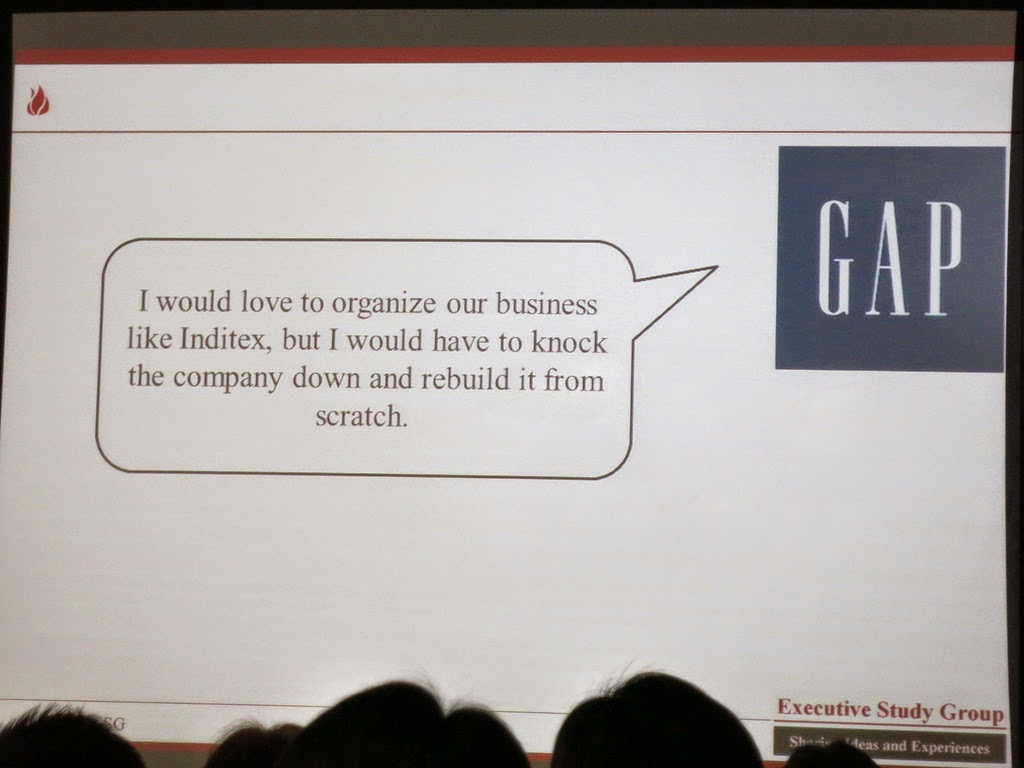In the beginning, Dr. Mark Lee (Research Director, APISL) introduced the content of seminar included "The Rise of a Legend”, “Industry Benchmarking”, “Secret Formulas behind Cost Challenges”, “Misconception about Core Competence”, “Strategic-Fit”, “Consistency and Reinforcement”, “Sustainable Competitive Advantages” and “Cross-Industry Sharing”.
Then Dr. Lee briefed how success of Zara in the fashion market. Zara (one brand of Inditex) sales and operating profits grew 25% per year over the period from 2000 to 2012. He quoted Pablo Isla (CEO, Inditex) statement “When you have a global presence, you have plenty of opportunities to open stores.”
After that Dr. Lee analyzed the top five sales apparel brands’ operation efficiency and found that Zara (Inditex) had 11 Inventory Turn!
Dr. Mark Lee started to explain the Zara secret formulas below.
i) Large Design Team
Zara employed around 200 designers and developed 12,000 different every year. Those designers tapped into Inditex’s sourcing specialists. (Professional segmentation) Store managers kept close track of shifts in consumer preference (Feedback from Sales) Their innovation didn’t follow seasonal collections.
ii) In-House Manufacturing
Zara maintained manufacturing capability for time-sensitive pieces; other less time-sensitive pieces were outsourced. They investment in machines assets to buy time.
iii) Global Supplier Network
Zara had 1,398 suppliers around the world but they reserved 85% of its in-house factories’ production capacity for in-season adjustments. Even though products sourced to Asia were estimated to be 20% cheaper to produce locally, time is much important than cost!
iv) Centralized Warehouse in Spain
All the brands followed the same central distribution center model (Efficiency!) and delivery the product within 24hr in Europe and 48hr anywhere else in the world.
v) Stores for Advertising
Zara had 1,925 stores and each store averaged 11,238 square feet. They didn’t budget for media advertisement but window displays were crucial for attracting customers. Those displays were updated every three weeks!
vi) Frequent Re-ordering
Store manager would select ~800 designs from the 2000 offered and feedback weekly to the design department on customer opinion. There were three store managers in the store separated into Men, Women and Child product lines. Centralized pricing cost was determined by adding the shipping cost to the market price in Spain.
vii) Regional Pricing Policy
They used shipping cost model so that the Japan price is 45% higher than the Spain. However, they didn’t afraid parallel import (水貨) because of time-sensitive collection. Since limited stock and most of pieces were full-price sales, so less discount would be employed.
viii) E-Commerce Synergy
Zara invested in e-commerce comparatively small than others but they only considered synergy between online and offline. It was because Zara shop was not for transaction but for customer experience.
Per Pablo Isla statement below, I only think one word “SPEED”! Everything Zara done is tailored to getting the latest styles into its stores fast.
I found interested in the coming topic “Misconception about Core Competence”. Dr. Lee said that you didn’t rely on core competence totally. It might be same core competences as everyone else in your industry and easier to be copied.
After that Dr. Lee introduced “Strategic-Fit” and he translated into Chinese term as “環環緊扣,相輔相成。”. It means that the whole matters more than any individual part and have synergy value when many parts together. Therefore, it is difficult to identify one or two core competences but the whole system. Nevertheless, their competitors are difficult to copy parts but the whole system.
Before the cross-Industry sharing, Dr. Lee gave us an exercise to find out two most and one least impressive functions of Zara. And then group discussion was performed.
Reference:
The Centre for Logistics Technologies and Supply Chain Optimization, CUHK - http://www.logitsco.cuhk.edu.hk/
HKSTP - www.hkstp.org
Information about Asia Pacific Institute for Strategy Limited (APISL) (亞太策略研究所有限公司)

























































